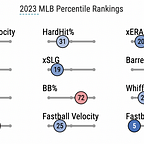How the Red Sox completely revamped Nick Robertson
Welcome to the offseason series in which I’ll be breaking down what changes each Red Sox pitcher made either during the season or before the season. First up: Nick Robertson.
Robertson was a fringe major-leaguer that struggled to stay in the majors with the Dodgers. The 25-year-old put up a 6.10 ERA in nine outings for the Dodgers before being sent down to Triple-A Oklahoma City, and was later dealt in the Kiké Hernandez trade along with Justin Hagenman.
The 6-foot-6 righty was immediately thrust into the majors with Boston on 8/6, where he allowed four runs in four innings across two outings (8/6 and 8/8) and was sent down to Worcester. It was there that he appeared to tweak a number of things; he completely shifted both his mechanics and arsenal by the time he was called back up in September.
What immediately brought Robertson a ton of hype was the changeup that yielded a ~25 SwStr% on it in Triple-A Oklahoma City. Robertson was mainly a two-pitch arm between the fastball and changeup while also occasionally mixing in a slider that wasn’t very useful. It was a solid arsenal but Robertson was keen to make tweaks with good but nowhere elite tunneling between the changeup and fastball as well as a slider that wasn’t being used/wasn’t effective. He had a 6.10 ERA in nine relief outings for the Dodgers before being traded to Boston — his first career big-league stint — and the batted ball data also wasn’t pretty, but there was clear potential in the tall righty due to a number of factors.
So, the Red Sox pitching staff went with the common trends of baseball: Robertson added a sweeper. The new asset picked up ~3" of carry on ~17" of sweep at 83, with a mid-7° VAA and a -5° HAA while also grabbing an even more impressive 2700 RPMs. It gives the pitch an impressive 155 Stuff+ on FanGraphs — which, give him a full season of that and that’s a top-10 pitch in the slider/sweeper category.
And, in the month of September, the new sweeper garnered just a .257 xwOBA against, while, he basically stopped using the changeup — only throwing the changeup 13% of the time in September with him becoming more of a fastball-sweeper arm. He only would use the changeup at a ~25% rate when he’s ahead in the count, while almost never when he’s behind in the count or with two strikes; also more to lefties than not. It may look like the transition wasn’t all that much of a success as he slated just a 4.50 ERA in his eight outings (on his second time up) with Boston, but in reality, it was a scoreless inning in all but one of eight — a rough outing where he allowed five runs in two innings against the eventual World Series Champion Texas Rangers. Subtract that outing and that’s a 0.00 ERA in that time frame.
Now, let’s take a look at what else was tweaked: Robertson’s stance on the mound. The photo on the left is from his 8/6 outing when he first came to Boston and how he was standing with Los Angeles plus when he first got to the Sox; the right is a Sunday Night Baseball 9/14 outing vs. the Yankees in his second stint up in the majors with the Red Sox.
Notice where he’s standing on the rubber — this moved his horizontal release point from ~1.5–2.0 to ~2.5–3.0 (it varies on the pitch). Pay attention to the rubber on these pictures.
Next, Robertson’s mechanics. I picked this out when I was searching for both the approach angle and velocity improvements on the fastball. The right-hander’s newer windup appears to be much taller.
The changes took his fastball from a -5° VAA to a -4.5° VAA, and his HAA on the pitch went from above -1° to below -2° (pay attention to the negative when I say above and below). Velocity on the fastball also improved from an average of 94.7 to 96.4 with this change —and despite his low spin rate on the fastball this still took the pitch’s Stuff+ from ~80 to 115. It gets a solid 16–17" of ride and 7–8" of run (which wasn’t touched with the tweaks).
The xwOBA on the fastball might not look all that great at .384 in the month of September, but the whiff rate on his 66 fastballs that month was still at an impressive 33%. Robertson has the potential to be a solid bullpen arm for Boston next season with these changes and I’m curious to see what the new pitching coach staff adds/tweaks with him as well.
